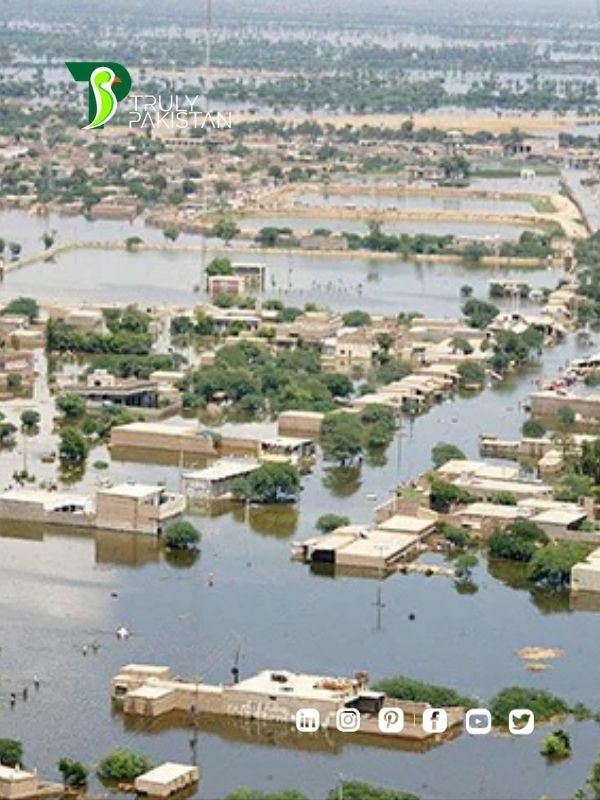Impacts of Climate Change on Pakistan: Data-Driven 2024 Guide


Pakistan is one of the countries most exposed to climate change, even though its share of global greenhouse gas emissions is less than 1%. Rising temperatures, destructive floods, and melting glaciers are reshaping lives and livelihoods across the nation. The impacts of climate change on Pakistan are no longer distant threats—they are unfolding here and now.
Agree: Scientists, policymakers, and communities all recognize that Pakistan is on the frontlines of climate change.
Promise: In this guide, you’ll find a clear, data-backed explanation of the major impacts of climate change on Pakistan, covering environment, economy, health, and policy.
Preview: We’ll explore current challenges, sector-specific risks, and what the future may hold by 2030–2050, plus how Pakistan is responding with adaptation strategies.
Pakistan’s Climate Vulnerability: Key Facts
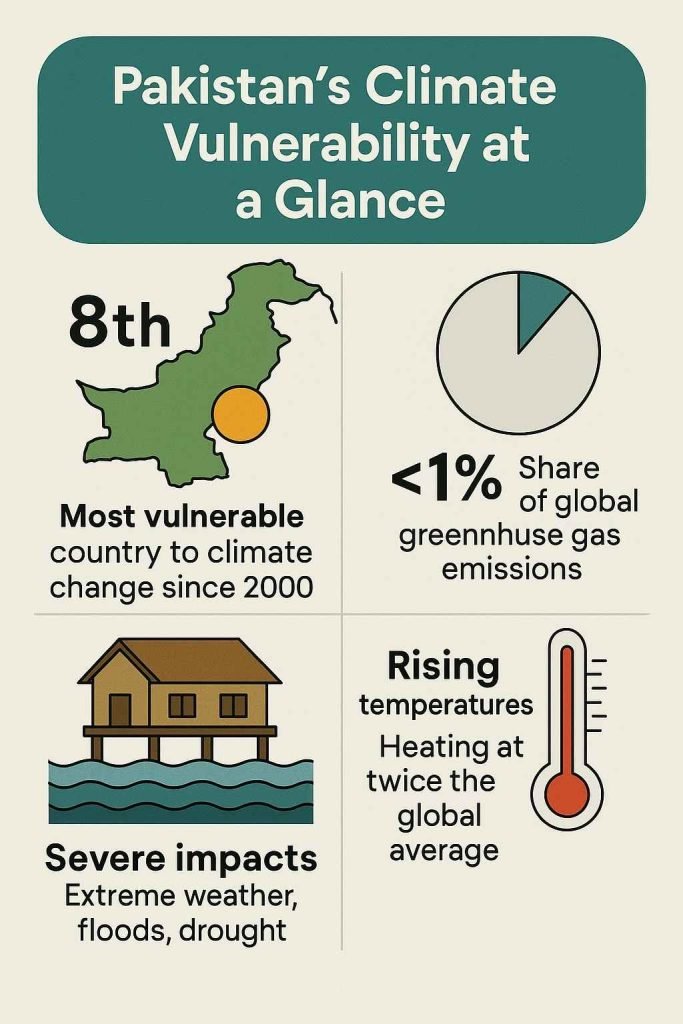

Global Risk Rankings Highlighting Impacts of Climate Change on Pakistan
Pakistan consistently ranks among the top 10 most climate-vulnerable countries in the world, according to the Global Climate Risk Index. In recent years, events such as the 2022 floods—affecting 33 million people—have only reinforced these rankings. This global acknowledgment highlights the severity of the crisis.
Pakistan’s Low Emissions vs. High Vulnerability
Despite contributing less than 1% to global carbon emissions, Pakistan is disproportionately suffering from climate impacts. The country’s economy relies heavily on agriculture and water resources—both sectors extremely sensitive to temperature shifts and erratic rainfall. This mismatch between contribution and consequence has made Pakistan a case study in climate injustice.
Geography and Socioeconomic Drivers of Climate Risk
Several factors magnify the impacts of climate change on Pakistan:
- Geography: Home to over 7,000 glaciers, vast arid zones, and a long coastline, Pakistan faces diverse climate threats.
- Economy: With 45% of its labor force in agriculture, shifts in rainfall and heat waves directly affect livelihoods.
- Population: Rapid urbanization and poverty levels increase vulnerability to disasters.
- Infrastructure: Weak disaster management systems and outdated urban planning heighten risks from floods and heatwaves.
Checklist: Why Pakistan is Highly Vulnerable
- Ranked 8th on the Global Climate Risk Index
- Contributes less than 1% of global emissions
- High dependence on climate-sensitive agriculture
- Over 220 million people exposed to climate extremes
Environmental Impacts of Climate Change on Pakistan
Rising Temperatures and Heatwaves
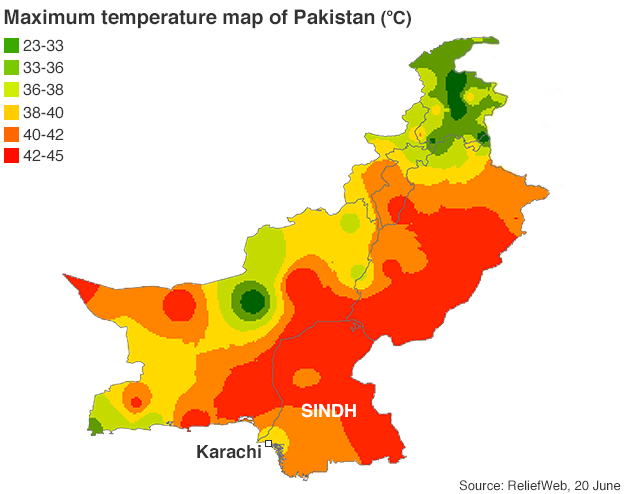

Average temperatures in Pakistan have already risen by about 0.5°C since the 1960s, and projections suggest an increase of up to 1.5°C by 2050 (IPCC). Extreme heatwaves in cities like Karachi and Jacobabad have reached record-breaking levels, making outdoor work dangerous and increasing mortality rates. These events also strain electricity demand due to rising use of air conditioning and fans.
Changing Monsoon Patterns and Rainfall Disruption
Pakistan’s monsoon cycle has grown increasingly erratic. Instead of steady rains, the country now experiences bursts of torrential downpours or prolonged dry spells. This shift disrupts agriculture, damages infrastructure, and increases the likelihood of both floods and droughts in the same year.
Glacier Melting and Indus Water Flow
Pakistan holds the world’s largest concentration of glaciers outside the polar regions. These glaciers feed the Indus River, the lifeline for agriculture and drinking water. But warming temperatures are accelerating glacier retreat, leading to reduced water flow in the long term and dangerous Glacial Lake Outburst Floods (GLOFs) in the short term.
Sea Level Rise Threats to Coastal Pakistan
Coastal areas in Sindh, particularly Karachi and the Indus Delta, face risks from rising sea levels and saltwater intrusion. Studies warn that by 2050, thousands of hectares of fertile farmland could be lost to salinity, and millions of coastal residents will face displacement.
Economic Impacts of Climate Change on Pakistan
Agriculture and Food Security Risks
Agriculture contributes about 19% to Pakistan’s GDP and employs nearly half of the workforce. Erratic rainfall, shifting seasons, and higher pest outbreaks reduce crop yields of wheat, rice, and cotton. These losses directly threaten food security and rural incomes.
Damage to Infrastructure and Energy Systems
Floods and extreme weather events frequently damage roads, bridges, and power grids. The 2022 floods alone destroyed over 2 million homes and caused infrastructure losses worth more than $30 billion (World Bank). Energy systems, especially hydropower, are also at risk due to changing river flows.
Tourism and Industrial Sector Losses
Tourism in northern areas suffers when landslides and floods block access routes, while industries in Sindh and Punjab struggle with supply chain disruptions during extreme weather events. Heat stress in urban centers also reduces labor productivity, adding hidden economic costs.
GDP Projections and Climate-Linked Costs
According to government estimates, Pakistan could lose up to 2–4% of its GDP annually by 2050 due to climate-related damages. These figures highlight how climate change isn’t just an environmental concern—it’s an economic emergency.
Did you know? The 2022 floods caused damages equal to 2.2% of Pakistan’s total GDP, pushing millions into poverty and reversing years of development gains.
Health and Social Impacts of Climate Change on Pakistan
Heat Stress, Mortality, and Public Health
Extreme heat is now one of the deadliest impacts of climate change on Pakistan. In 2022, Jacobabad recorded temperatures above 50°C, making it one of the hottest places on Earth. Such extremes cause dehydration, heat stroke, and increased mortality, particularly among outdoor workers and elderly citizens.
Vector-Borne and Water-Borne Disease Spread
Rising temperatures and erratic rainfall expand the breeding grounds for mosquitoes and other carriers of dengue, malaria, and chikungunya. Floods also contaminate drinking water sources, leading to cholera and typhoid outbreaks in affected regions. The World Health Organization warns that climate-linked health crises could become Pakistan’s “silent epidemic.”
Climate-Induced Migration and Displacement
When floods destroy homes or droughts kill crops, families are forced to migrate. The 2022 floods displaced over 8 million people, with many still struggling to rebuild. This migration places added stress on urban centers like Karachi and Lahore, which are already grappling with housing and resource shortages.
Disproportionate Impacts on Women and Vulnerable Groups
Women, children, and marginalized communities often bear the brunt of climate disasters. Limited access to healthcare, food, and shelter deepens inequality. Rural women in particular face higher workloads as they walk longer distances to fetch water or firewood when resources run scarce.
Extreme Weather Events and Disasters
2022 Pakistan Floods: Causes and Economic Toll
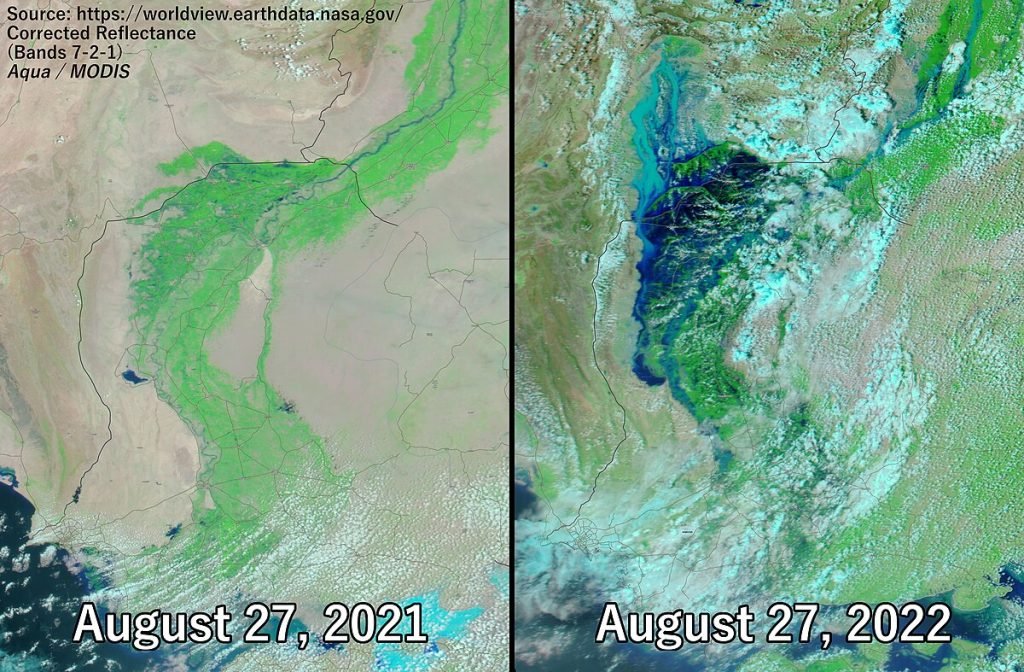

The 2022 floods—triggered by unprecedented monsoon rains—submerged one-third of Pakistan. More than 1,700 lives were lost, 33 million people were affected, and damages exceeded $30 billion (World Bank). It remains the clearest example of the devastating impacts of climate change on Pakistan.
Droughts and Water Scarcity in Arid Regions
Balochistan and Tharparkar are especially vulnerable to prolonged droughts, which devastate crops and livestock. These conditions worsen food insecurity and trigger seasonal migrations as families search for water and work.
Glacial Lake Outburst Floods (GLOFs) in Northern Pakistan
Melting glaciers in Gilgit-Baltistan and Khyber Pakhtunkhwa are creating unstable glacial lakes. When these lakes burst, they unleash sudden floods known as GLOFs. The UNDP estimates that more than 7 million people in northern Pakistan are at risk from these events.
Urban Heat Islands and City-Level Challenges
Major cities like Karachi, Lahore, and Islamabad are heating up faster due to concrete expansion, vehicle emissions, and deforestation. Combined with poor air quality, these “urban heat islands” create severe public health risks.
FAQ on Impacts of Climate Change on Pakistan
How vulnerable is Pakistan to climate change?
Pakistan ranks among the top 10 most vulnerable countries on the Global Climate Risk Index. Its geography, reliance on agriculture, and rapid population growth increase exposure to floods, droughts, and heatwaves.
What are the major impacts of climate change on Pakistan’s economy?
The economy faces damages to agriculture, infrastructure, and industry. The 2022 floods alone cost $30 billion, equal to 2.2% of GDP. Projections suggest climate change could shave 2–4% off GDP annually by 2050.
Why is Pakistan so affected despite low emissions?
Although Pakistan contributes less than 1% of global emissions, it lies in a climate hotspot—between melting glaciers in the north and rising seas in the south. High poverty and weak infrastructure further amplify the damage.
Which provinces of Pakistan are most impacted?
Sindh faces recurring floods and coastal erosion, Punjab sees crop losses, Balochistan endures drought, and the northern areas risk glacier melt and GLOFs. Urban centers like Karachi and Lahore also struggle with heatwaves and poor air quality.
What is Pakistan doing to fight climate change?
Pakistan has adopted the National Climate Change Policy, updated its Paris Agreement commitments, and launched projects like the Billion Tree Tsunami. However, it still requires significant international climate finance and support.
Regional Breakdown of Impacts
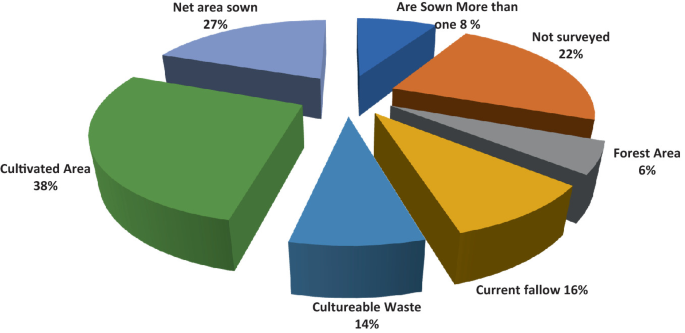

Punjab: Agriculture Under Climate Stress
Punjab, the breadbasket of Pakistan, is witnessing declining wheat and rice yields due to shifting rainfall patterns and rising heat. Farmers face higher irrigation costs as groundwater levels fall, making food security increasingly fragile.
Sindh: Floods, Sea Level Rise, and Heat Extremes
Sindh is among the most climate-stressed provinces. The Indus Delta is shrinking from sea intrusion, while floods frequently displace rural populations. Karachi, Pakistan’s largest city, regularly experiences deadly heatwaves and urban flooding.
Balochistan: Drought and Desertification
Balochistan’s arid landscape makes it highly vulnerable to droughts. Water scarcity leads to crop failures, livestock deaths, and migration. Expanding desertification is already threatening livelihoods in districts like Chagai and Quetta.
Northern Areas: Glacier Retreat and Water Security
Glacier retreat in Gilgit-Baltistan and Khyber Pakhtunkhwa poses a dual risk: water shortages in the long term and sudden floods in the short term. These regions, home to Pakistan’s hydropower projects, will face challenges in energy supply as river flows fluctuate.
Urban Centers: Karachi, Lahore, Islamabad
Major cities struggle with heatwaves, air pollution, and flash floods. Urban sprawl combined with poor infrastructure amplifies vulnerability. Heat-related productivity losses in cities already cost millions annually.
Pakistan’s Climate Change Response
National Climate Change Policy 2012 and Updates
The National Climate Change Policy (2012, updated 2021) sets the foundation for adaptation and mitigation. It outlines measures in agriculture, water, and energy, but implementation remains inconsistent.
Paris Agreement Commitments and NDCs
Pakistan has pledged a 50% reduction in projected emissions by 2030, conditional on international support. Its updated Nationally Determined Contributions (NDCs) stress renewable energy adoption and reforestation.
Adaptation Strategies and Green Initiatives
Projects like the Billion Tree Tsunami, renewable energy investments, and climate-resilient infrastructure are positive steps. Yet, funding and governance gaps limit large-scale progress.
International Climate Finance and Support Needs
Pakistan requires billions in annual financing to adapt effectively. At COP27, it successfully pushed for the “Loss and Damage” fund, highlighting the global recognition of its disproportionate climate burden.
Future Outlook: Impacts of Climate Change on Pakistan by 2030–2050
Projected Temperature and Rainfall Changes
By 2050, temperatures could rise by 1.3–1.5°C, while rainfall patterns will grow increasingly unpredictable. This will heighten both droughts in arid zones and flash floods during intense monsoon bursts.
Economic and Development Forecasts
Without adaptation, climate-linked costs could exceed 4% of GDP annually. Food insecurity, displacement, and damaged infrastructure will remain key challenges for development planning.
Water Resource and Agriculture Projections
Glacier-fed Indus River flows may decline, threatening irrigation systems. Crop yields of staples like wheat and rice are projected to drop by up to 15% in worst-case climate models.
Investment Priorities for Resilience
Future planning must emphasize renewable energy, climate-smart agriculture, disaster-resilient housing, and early warning systems. Investment in these areas will determine how well Pakistan adapts.
Conclusion: Building a Climate-Resilient Pakistan
The impacts of climate change on Pakistan are already visible in flooded fields, parched lands, and displaced communities. Yet, the future is not predetermined. With bold policies, international support, and local action, Pakistan can reduce risks and build resilience.
Call to Action: Support Pakistan’s climate resilience journey by learning more about the National Adaptation Plan and contributing to local initiatives tackling climate challenges.
About the Author
Author: ZunNurain Khalid — Travel & Tourism Specialist, Founder of ExploreX Pvt. Ltd., and advocate for sustainable tourism in Pakistan. With over a decade of experience in digital marketing and destination branding, ZunNurain has worked extensively on promoting Pakistan’s natural and cultural heritage.

